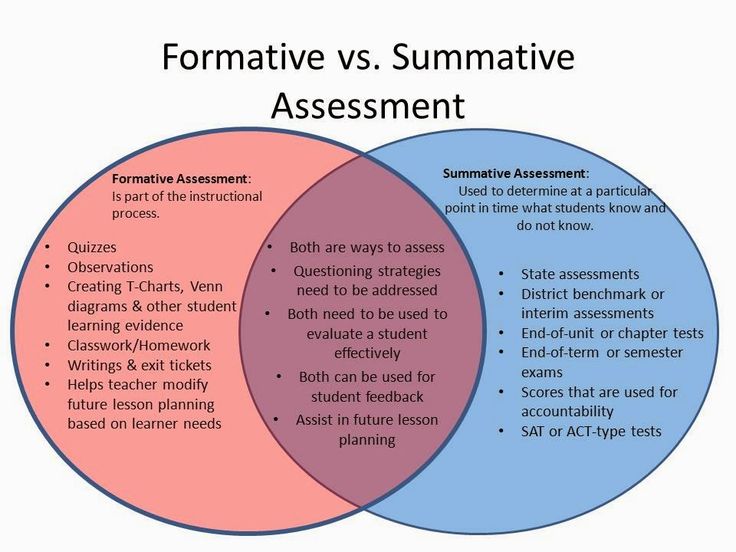Post 2 The benefit of formative evaluation and summative evaluation in learning

I think formative evaluation and summative evaluation are both very effective learning methods. Formative evaluation is to gradually improve and perfect the teaching activities in the teaching process to grade students, processes and results. The summative evaluation is to evaluate what students have learned in a large learning stage. Purposeful summarization and evaluation can often urge learners to study independently and strenuously. Because after the summative evaluation, learners can see the results they get. Learners can reflect and share through group communication. With this method, learners can share what they have learned recently. In our daily learning life, the degree of knowledge mastery is the most intuitive assessment content for the effectiveness of learning. There are many different testing methods. Among them, the examination is the most popular assessment tool to test the degree of learning mastery. For teachers, the examination is a relatively easy method to create and manage the assessment of students’ learning mastery, and the results obtained after the test are more intuitive.
Like in economics courses, different teachers will use different methods to check students’ learning outcomes periodically. Many teachers do not usually assign any homework to students, usually, there are only two to three exams in a semester. Teachers gradually improve and perfect their teaching methods through the performance of students in the learning process. After the first mid-term exam, teachers can use the students’ first mid-term exam results to determine the difficulty of the courses they teach and make improvements. This is an educational process of formative evaluation. Many students may not keep up with the teacher’s course in the initial learning process and get very low scores in the first exam, but this does not mean that they will fail the class. Because the teacher’s syllabus often mentions that the higher midterm exam may account for more total scores (eg: better midterm 25%, worst midterm 15%, or better midterm will cover worse midterm). This approach can often motivate students to do better in the rest of the semester. Students will not affect their learning progress because of a mistake, and they can do better the next time.
Students can also know their shortcomings from their first test afterward they can improve their learning methods and get better results in the upcoming exams in the rest of the semester. The final exam is a summative evaluation. It is a summary evaluation of what students have learned during a large learning stage. The periodic evaluation during the mid-term exam will not significantly impact the summary evaluation (in economics). In the department’s final exam, the final exam often accounts for a large proportion (eg 40%-50%). This kind of purposeful summative assessment can often urge students to study independently, and students can see their learning results after the final exam.
And these two evaluation methods can make teachers and students realize the good and bad aspects of their own work at this stage. Teachers can observe students’ exams to understand the difficulty of their own teaching methods and make improvements. Students can also use exam results to understand their mastery of knowledge points.
Photo reference:
History and Government: What are the functions of formative evaluation?
Post 1 Different study experience between two countries (behaviorism, cognitivism, and constructivism).
Before I came to Canada to study language courses, my high school and previous courses were all completed in China. But when I came to Canada, I found that the two countries used completely different education methods to educate students.
Teachers in Canada often use constructivism and behaviorism to enable students to learn knowledge. The teaching method of Canadian teachers is a kind of trial education. Let the students try and experience first, find difficult points in the experience to accumulate experience, and finally, conclude. The final kind of conclusion is the result of my research. In many of my professional courses, the teacher will ask students to write a research paper, but the teacher does not fix the topic, the students can have their ideas to choose the content they want to research and then communicate with the teacher. After the teacher knows the student’s topic, he will use a series of step-by-step processes to guide the student and narrow the scope of the research until the student determines the specific topic he wants to write. Teachers can improve their analytical thinking in this way. They can use their way of understanding to analyze problems instead of relying on the teacher to give them answers.
In China, teachers use cognitivism more often. Chinese-style education is a kind of indoctrination education. It tells students the successful experience of others and allows students to operate according to their existing experience. They lack the process of their practice. Most of the students learn and practice under the guidance of experience. In this case, it is often difficult for students to get their theories, and it is also difficult for students to break out of a fixed model and lack an innovative spirit. And when Chinese students are learning knowledge, teachers expect students’ answers to be fixed answers. If students have their thinking mode and ask questions, many times they will be regarded as wrong answers. Teachers always expect students to think by inherent thinking. For example, when I was reviewing the English exam in the third year of high school, the teacher would sort and analyze the sample essays for the college entrance examination. And let us memorize those excellent model essays in China, and write an essay according to the excellent template can always get high marks. But for students, this way of learning is very boring. Although students can get high scores, they lack their thinking mode.
In general, students will encounter different behaviorism, cognitivism, and constructivism in their study life to help them learn. Different countries may be more inclined to different education methods, but these methods are not wrong. Learning different types of education at different times can enable students to learn knowledge.
Hello everyone
Hello everybody!
I am Aini Jiang, I am from China. I study Economics at UVic, and this is my final semester at UVic.
I like playing video games and watching TV series. I hope can have fun during the last semester of my university experience.


Welcome and Introduction
Before proceeding with this first blog post, we expect you to consider your privacy preferences carefully and that you have considered the following options:
- Do you want to be online vs. offline?
- Do you want to use your name (or part thereof) vs. a pseudonym (e.g., West Coast Teacher)?
- Do you want to have your blog public vs. private? (Note, you can set individual blog posts private or password protected or have an entire blog set to private)
- Have you considered whether you are posting within or outside of Canada? This blog on opened.ca is hosted within Canada. That said, any public blog posts can have its content aggregated/curated onto social networks outside of Canada.
First tasks you might explore with your new blog:
- Go into its admin panel found by adding /wp-admin at the end of your blog’s URL
- Add new category or tags to organize your blog posts – found under “Posts” (but do not remove the pre-existing “edci335” category).
- See if your blog posts are appearing on the course website (you must have the the edci335 category assigned to a post first and have provided your instructor with your blog URL)
- Add pages, if you like.
- Include hyperlinks in your posts (select text and click on the link icon in the post toolbar)
- Embed images or set featured images and embed video in blog posts and pages (can be your own media or that found on the internet, but consider free or creative commons licensed works). To embed a YouTube video, simply paste the URL on its own line.
- Under Dashboard/Appearance,
- Select your preferred website theme and customize to your preferences (New title, new header image, etc.)
- Customize menus & navigation
- Use widgets to customize blog content and features
- Delete this starter post (or switch it to draft status if you want to keep it for reference)
Do consider creating categories for each course that you take should you wish to document your learning (or from professional learning activities outside of formal courses). Keep note, however, that you may wish to rename the label of the course category in menus (e.g., as we did where it shows “Learning Design” as the label for the “edci335” category menu. This will enable readers not familiar with university course numbers to understand what to expect in the contents.
Lastly, as always, be aware of the FIPPA as it relates to privacy and share only those names/images that you have consent to use or are otherwise public figures. When in doubt, ask us.
Please also review the resources from our course website for getting started with blogging:
- WordPress resources
- Using RSS feeds to read blog posts from your networks (e.g., Feedly)
- Privacy resources
- Copyright resources
- Finding images you can use


Test Learning Design Post
This post will appear in a few places:
- in the blog feed on the front of your website
- in the Learning Design menu on your website. This is because we have applied the “edci335” category to this post and the menu item “Learning Design” has been created from the category “edci335.” For every post you make for this course, please assign the “edci335” category to it. You are welcome to use this blog for your personal hobbies or for other courses, in which case, you could create additional menu items and categories for them.
- if you give permission, your posts categorized “edci335” will be aggregated onto the Blog Feed on the EDCI 335 Course Website.
Feel free to delete this post once you understand this. If you have any questions, please reach out to your instructor.